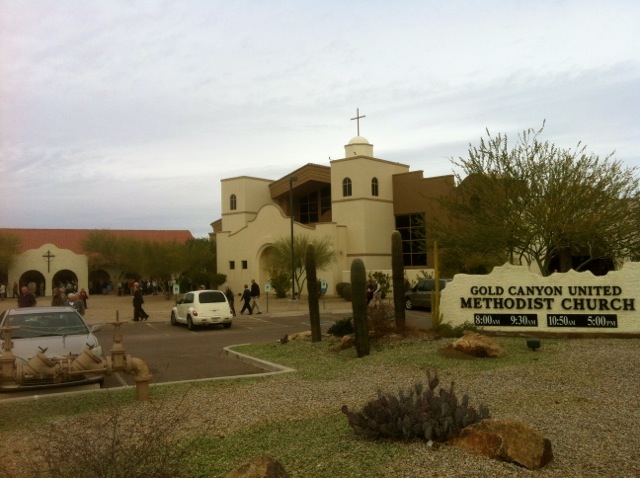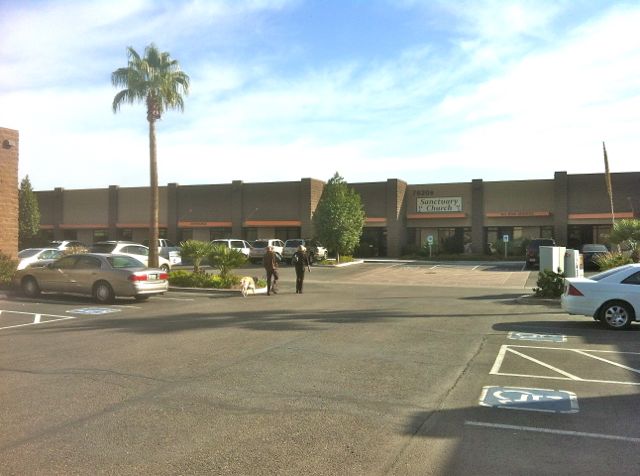MORE THAN JUST A BUILDING...
On our winter RV travels, we recently visited two very different (for us) United Methodist Churches. These two experiences offered an interesting insight into just what it is that we casually refer to as a “church”.
Gold Canyon United Methodist Church
We had spent two nights in Apache Junction, Arizona -- a favored snowbird roost for RVers. Since this included a Sunday morning, we did our usual online search to see what local Methodist churches might be somewhere in the neighborhood.. One website sounded particularly friendly. It was the United Methodist Church in nearby Gold Canyon.
We’ve been visiting various parts of southern Arizona in winter months for the past 20 years; and 20 years ago there was no such place as Gold Canyon. With the housing boom in Arizona in the late 1990s and early 2000s this area literally rose up from the desert floor as a series of newly constructed housing developments catering to those who longed to spend their winters in a warm and sunny climate. Over the years, Gold Canyon has changed from a cactus-covered desert to a thriving community of over 10,000 residents. It would be interesting to see how the local United Methodist Church had played into that growth.
From our campground, we drove about 15 minutes east on US 60, and turned north into a sea of new housing, all favoring southwestern architecture making generous use of adobe materials and soft sand colors. The traffic suddenly became heavier, and we soon realized we were not the only ones headed to the 9:30 service at the Gold Canyon UMC. Indeed, as we approached, we were amazed to see what appeared to be multiple acres of parked cars around a very large multi-storied sprawling church complex.

We found a parking spot and entered the foyer through a side door -- where we had our first look into the sanctuary. Though it was only about 9:25, the Pastor was already engaged in informal conversation with the congregation, mostly about a series of forthcoming events. But what was most striking was the fact this enormous church, five minutes before the advertised start of the 9:30 service, was seemingly full.
As we scanned the interior of the church, it appeared virtually every seat in this theatre-style seating area was occupied. One of the greeters apparently spotted us as visitors, and pointed to both an elevator and a staircase leading to what we inferred must be more seating in a balcony. And so it was. As we later learned the main floor accommodates approximately one thousand persons; and the balcony will hold approximately 200 more. The main floor was indeed entirely full, and most of the balcony seating was now occupied as well.
The service itself was at once both familiar and unfamiliar. The agenda of items comprising the service were quite similar to what we’ve become accustomed to in our two “home churches”, Bend and Florence. But there was something about the sheer size of what was going on around us that is difficult to describe. Early on there was the usual “take a moment to greet those around you” event. But since everyone was in a “full house theatre” the most one could do was to greet those immediately in front and behind; and on the left and the right. No doubt because we were first-timers it had somewhat the feeling of being an audience rather than a congregation. It was at first difficult to get beyond the sense of being a spectator at an event.
That is not to take away from the quality of the experience; rather it’s simply to recognize that there is a bit of an adjustment that’s needed when experiencing a church service on such a dramatically larger scale. With the first notes of the opening hymn, the sound of so many persons singing together was at first overwhelming -- almost as if you were compelled to just “listen”, rather than participate. And later when the 41 person choir took center stage, the quality of the music was on a scale we’ve seldom seen outside of a professional production. It was not the massive structure that we found compelling; rather it was the energy represented by such a large number of people gathered to worship together.
The Following Weekend: A Formative Church in Marana
The following weekend we were staying at a campground just west of Tucson, quite near the Sonoran Desert Museum. We again checked online to find what local UMCs might be nearby. Given the experience of attending such a large church the week before, we found one that stood out in sharp contrast. It was the Marana Sanctuary Methodist Church, located just to the north of Tucson, and accessible to us by way of a wonderfully scenic drive through the Saguaro National Monument. The website was both personal and welcoming, and told of a church that aspired some day to have a “real” church building of its own; but which for the moment had leased space in what was described as a strip mall. Fascinating!
We entered the destination address into our trusty GPS device, and followed directions to what appeared to be a modern industrial park, the Continental Commerce Park. On a sign in front of the complex was a listing of the businesses within -- a series of small shops, store fronts, and offices -- one of which was labelled “Sanctuary”. The rental spaces all looked very similar, but we finally noticed a large banner reading “Sanctuary Church”. It was not easily spotted, and it gave new meaning to the words “looking for a church”.

This was certainly a quite different “first look” than we’d had just a week earlier in Gold Valley, where the very large and sprawling multi-story complex was surrounded by acres of its own parking area. Yet at the same time it was intriguing.
We entered the front door into a small reception area where a group of mostly young families were chatting before the scheduled 10:30 service. What was immediately noticeable was how warmly welcomed we were by virtually everyone in the room. While we weren’t wearing “First Timers” buttons, it was almost as if we’d been doing exactly that. There is a distinct difference between a standard casual greeting and a genuinely sincere expression of welcome. What we both experienced was of the latter type -- and we could both sense and feel the spirit of oneness in this congregation. The level of energy and enthusiasm was contagious.
There are three choices for Sunday services at this church. You can choose the 7:45 AM traditional service that is shortened to about 45 minutes; a 9:00 traditional service; or a 10:30 contemporary service that features modern gospel type music and instrumentation. We’d opted for the latter, which perhaps accounted for the number of young families we met. The format of the service had some of the elements of the traditional service, though far less formal, and the music featured guitars, a drummer and three singers, all in their teens or 20s. We noted that there was not the traditional lighting of a candle to begin the service. But as we contemplated that fact later we concluded that in lieu of that tradition the light of Christ had indeed been in the eyes of all those we’d met on our way in.
During the course of our visit we learned that this church had started within the last five years as a group of 12 persons; and it had grown to a point where now the average Sunday attendance is 240 persons. Last fall we attended a special session led by the Assistant to the Bishop at our Bend UMC, which was considering a program called “The Healthy Vital Church Initiative”. That presentation included an analysis of how a church has a unique “life cycle”. This cycle can be identified with reference to four characteristics: Vision, Relationships, Program, and Structure. These tend to occur in precisely that order. A church tends to be more successful when it can retain the characteristics of the first two of these elements; and somewhat less successful when it matures toward the last two. In the Marana congregation we could instinctively sense we were surrounded by both vision and relationships. It seemed to fit perfectly the description of the early life cycle of a church.
In the period of two consecutive Sundays we had witnessed two very different church settings, ranging from what one might describe as a mega-church in Gold Valley, to a rapidly growing, vibrant new congregation about to outgrow its physical home in leased commercial space in an industrial setting. Yet in both cases the physical structure was decidedly not what we had found impressive. Rather it was the energy and enthusiasm of the congregation joined together in a service of worship in decidedly different surroundings. For us it provided a strong underscore to the notion that “a church is more than just a building.”